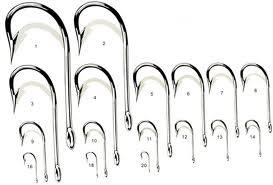Fishing hooks have been used since thousands and thousands of years. According to records, history suggests people used fish hooks even back in 7000BC. And through time, the materials and elements in the developments of hooks have changed. Wood, stone, bones, shells, bronze, iron and other sorts of materials were used in the production of hooks; and it is a fact that people still use non metallic hooks in some parts of the globe today. Hooks which were made by using steel first appeared and then significantly grew popular for professional use after the sixteenth century.Fishing hooks are tools which are used for catching fish. Like the name "hook," itself suggests, the tool is shaped like a hook and it contains a barbed edge which captures the fish and disables it to wriggle its way out of the hook. A hook is divided into various parts, such as:
The barb can be defined as the projection extending backwards from the point that secures your catch from unhooking during the fight. The angle and elevation of a particular barb affects the hooks performance. Many anglers opt to use barbless hooks. This can be for a more sporting angling experience or in many cases, when mandated by law for catch and release and conservation initiatives. Check your local regulations concerning hook barbs for particular species and bodies of water.
The point is the sharpened end of a hook that is designed to penetrate a fish’s mouth. Basic design parameters dictate that the point penetrate with the least amount of pressure and maintain a sharp and durable point for as long as possible. There are many different types of points and sharpening techniques used in modern fishing hooks. The different point types can aid in species and technique specific fishing and will be addressed in my more detailed series pertaining to specialized hooks. We are looking for the perfect balance of sharpness and durability.
The bend of a hook is the curved portion of the hook that connects the hook shaft to the point. Although the hook bend is curved, the hook point and shaft are generally straight portions of metal that run parallel to one another.
Gap or Gape This is the distance between the point and the shank and is known as the gap or gape. The gap of a hook is the vertical distance between the shank and point of the hook.
The size of a particular hook is generally determined in accordance with the size of the hook's gap.Bait or throat The distance from the apex of the bend to its intersection with the gape.The Eye of a fishing hook is the ring, hole, or loop at the end of the shank through which the line or leader is attached. There are some variations in eye types including; open eye for aftermarket attachment to lures and ringed eye for tying heavy leader to smaller hooks when typically bait fishing. Eye position is another relevant variation between different types of hooks. A turned down eye (like the example in the attached image) is turned down from the shank. A turned up eye is the opposite with the eye turned up and away from the shank. An in-line or parallel eye is just as it sounds with the eye being in-line with the shank.The shank is the leg of a hook extending from the bend up to the eye. Hook shanks are manufactured in many different shapes. The most commonly used are straight shank, curved shank, and sliced shank. Specialized hooks, such as those designed for jigs and soft plastic baits for bass, have shanks with various bends and angles. Again, look for details in the upcoming specialized hook series.
See my previous posts: Fishing Knots











